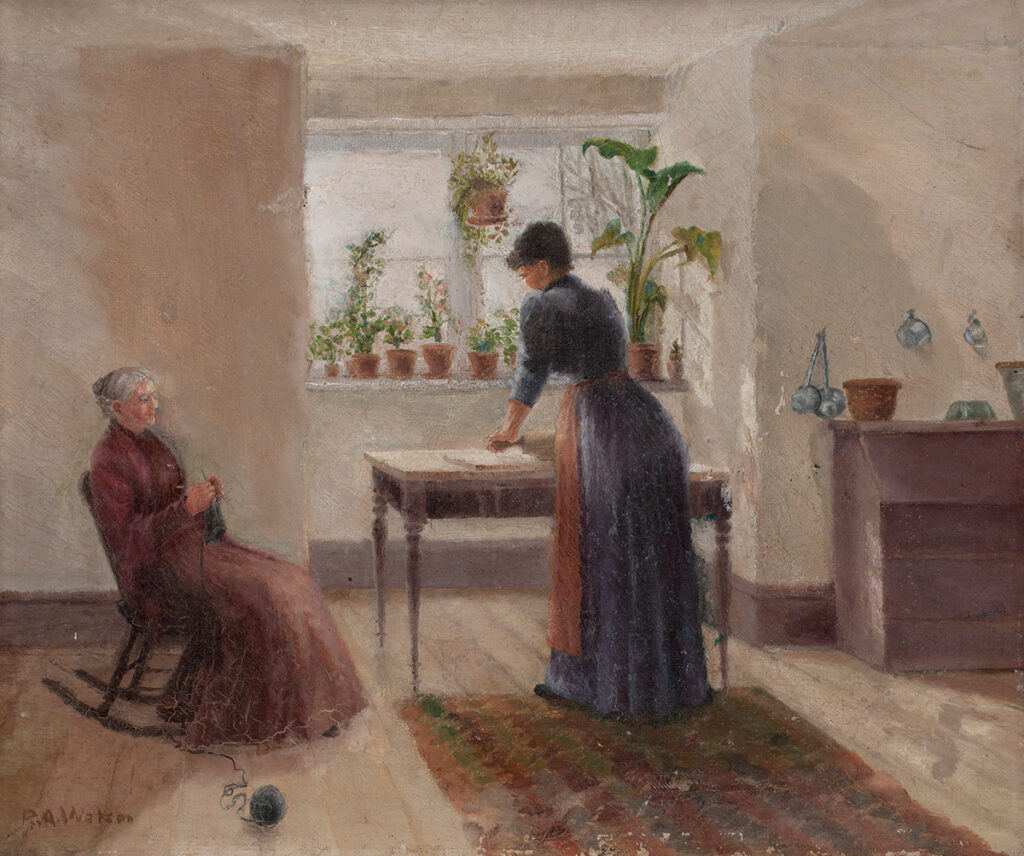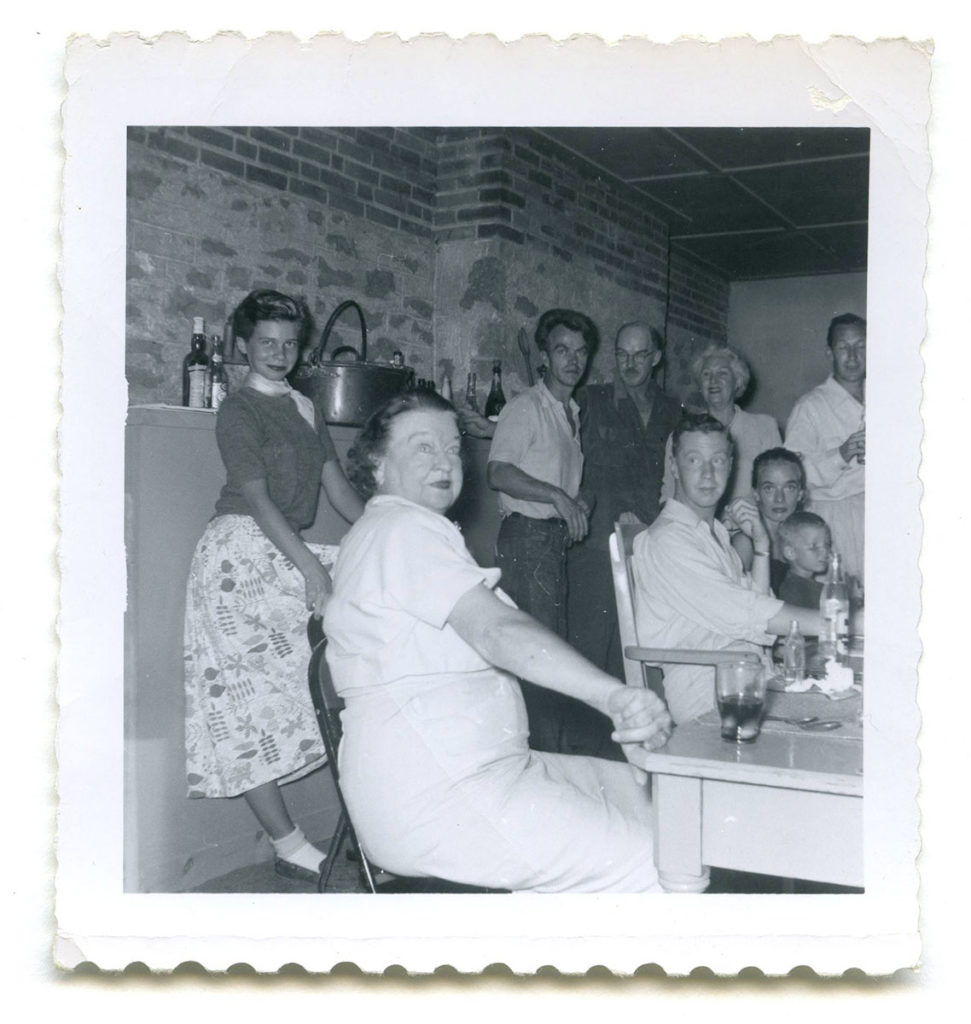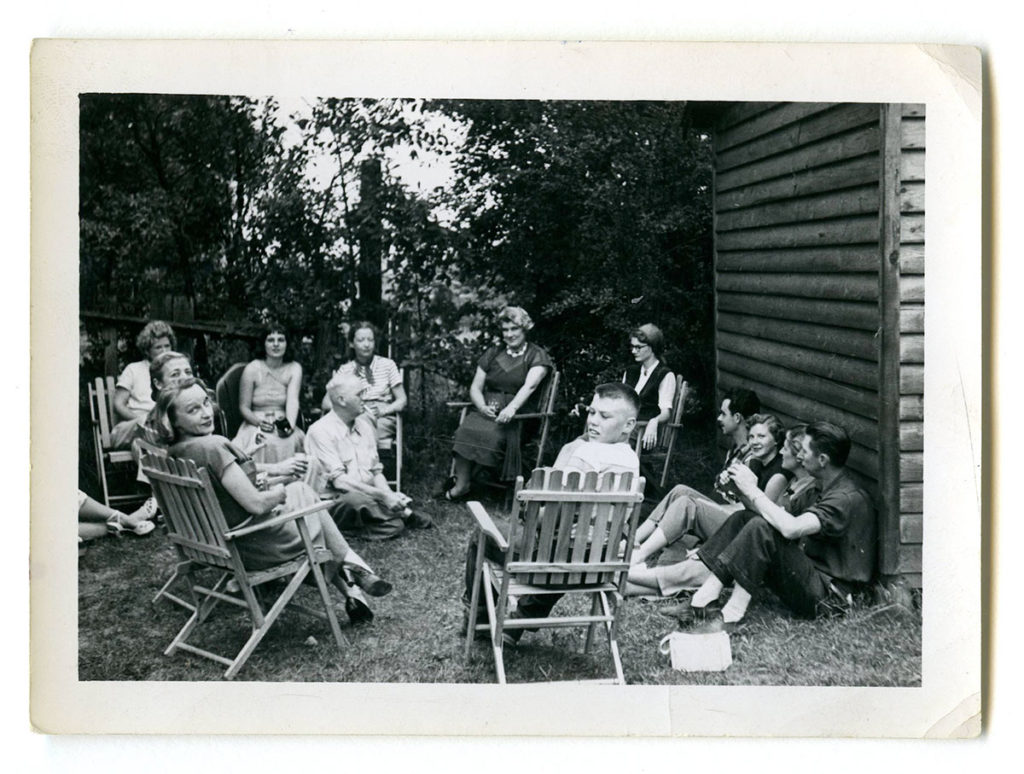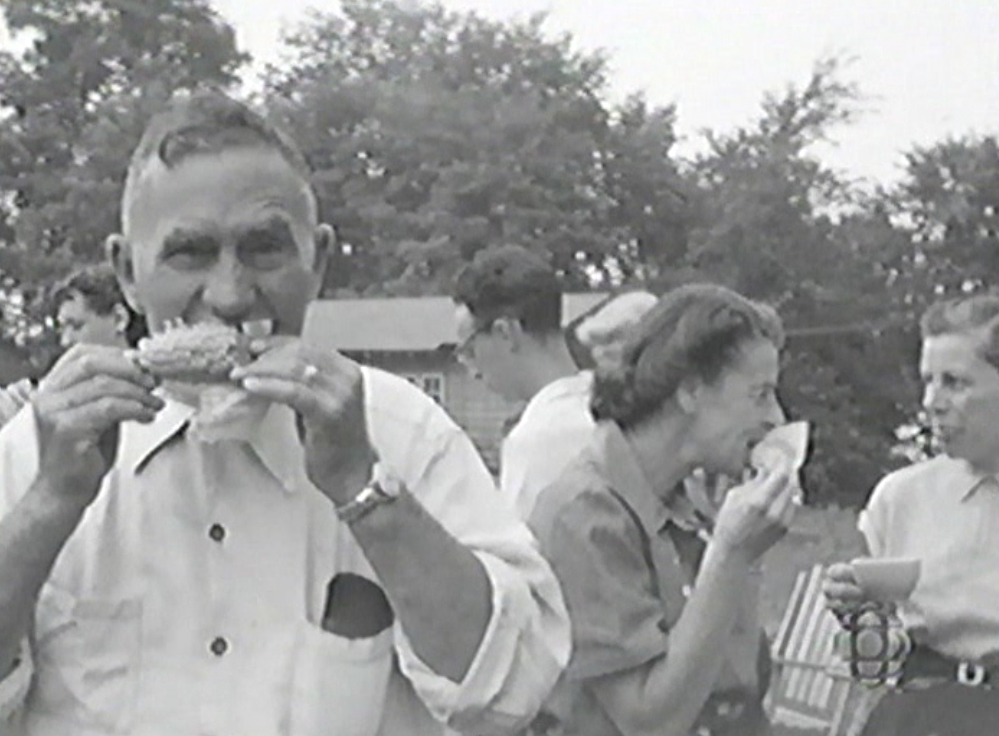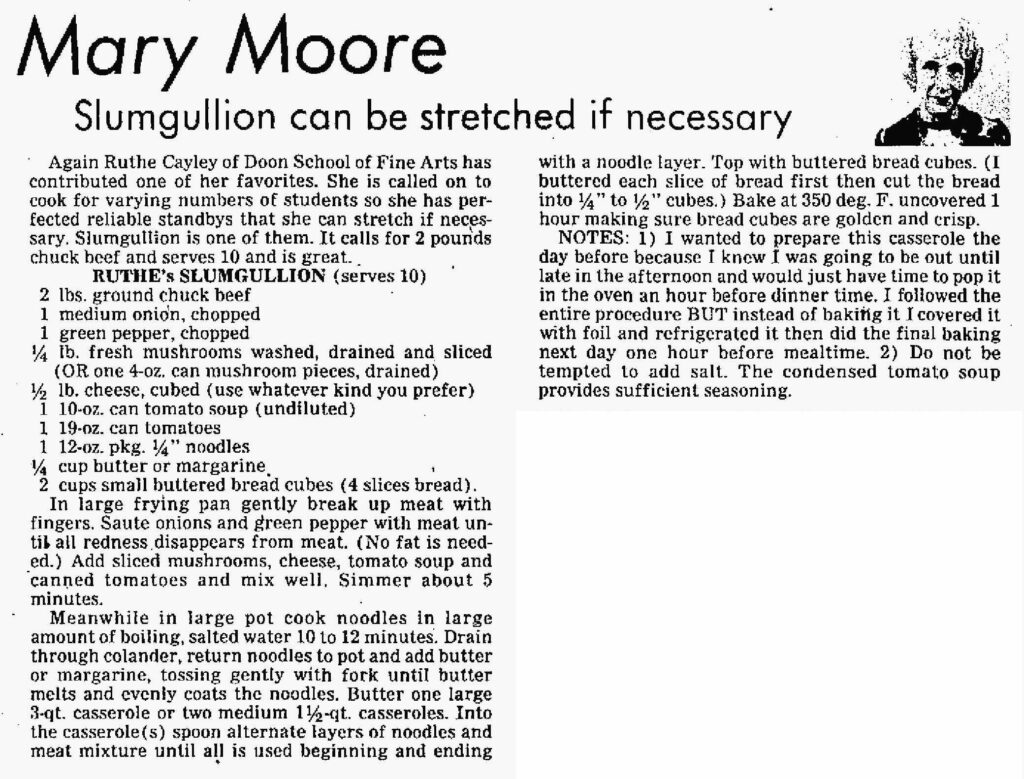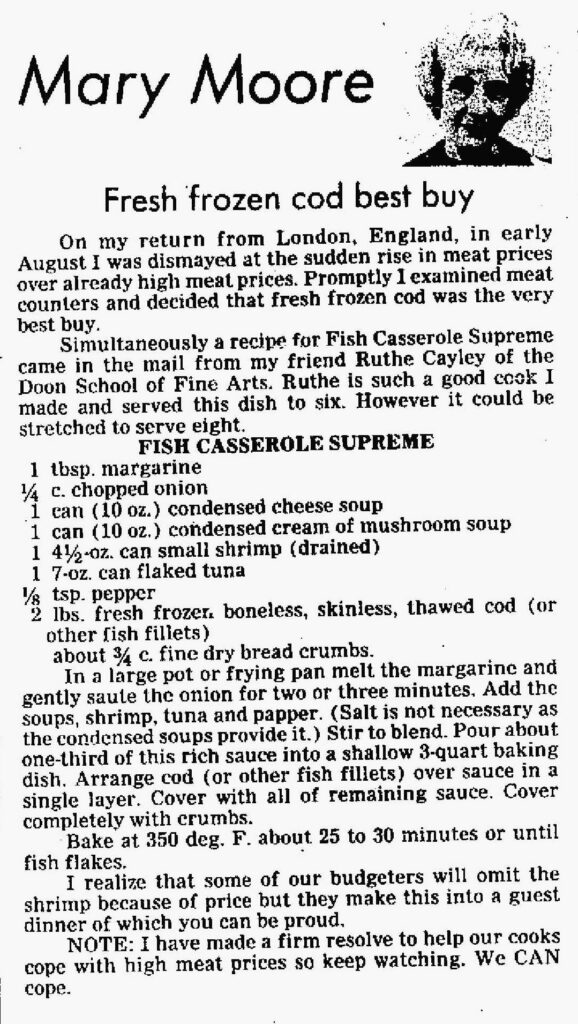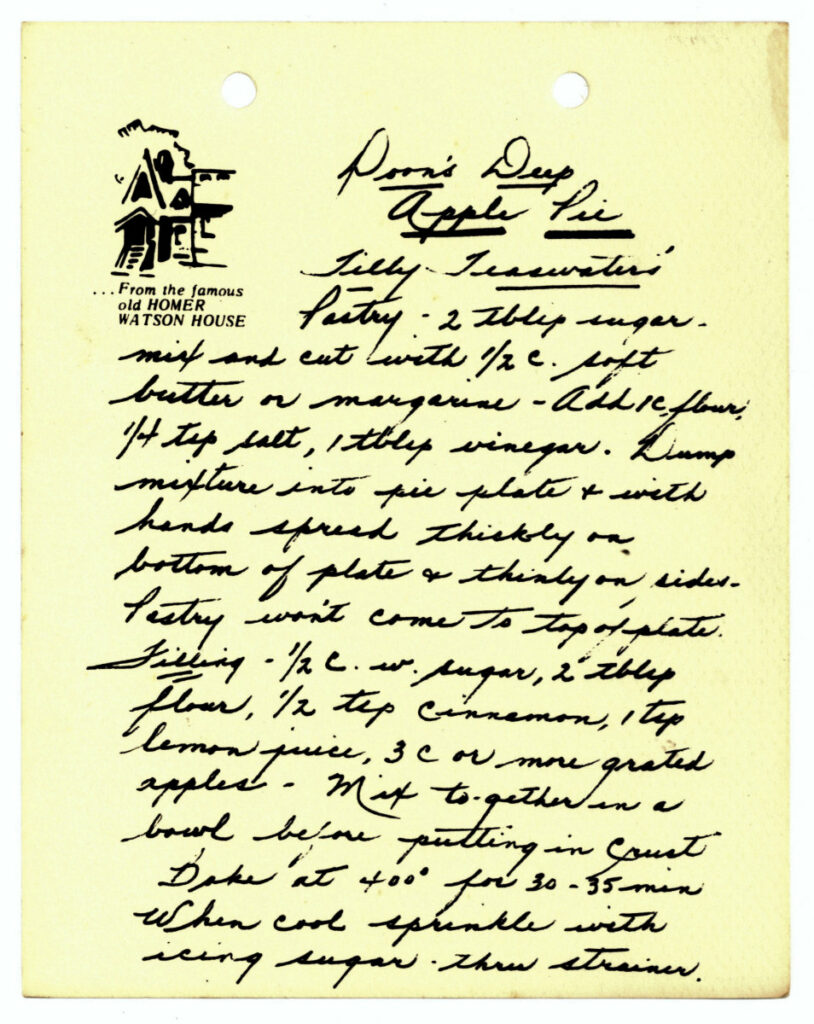Food and History
Throughout the history of the Watson House, many families and groups have enjoyed gathering to share a meal. Originally, the basement was the kitchen and dining room. The Watson family and students of the Doon School would have met in this space to share different kinds of food and drink that reflected their respective times.
To highlight the food history of the Watson House, we have compiled recipes and descriptions of dining experiences throughout the House’s historical periods.
Watson Period
“At meals at the house Roxy always had a loaf of crusty bread (from Doon bakery) in front of her at the table […] Roxy used a fancy flat fork with a bone handle, on which she placed a slice of bread to pass to each guest.”[1]
Roxa Watson was known as an excellent cook, and her many nieces and nephews looked forward to eating her delicious meals. Though the exact recipes are lost to time, interviews with members of the Watson family include descriptions of the kinds of food and drink that were served.
Phoebe Watson’s hospitality was extended to all who came to visit the House. She is said to have served tea and cookies to guests in her “tea room”.[2] Even on a Sunday, with a house full of gallery visitors, Phoebe would prepare a meal – though perhaps not in the timely manner her nieces would have appreciated: “When we thought that we’d die (with hunger), well then Phoebe would say, well I guess I’ll go and put the potatoes on.”[3]
Roxa’s Banana Salad
One of Roxa’s recipes was a banana salad. It was described by one of her nieces as “a leaf of lettuce on a salad plate, then sliced bananas, onions and a creamy dressing”.[4] While we do not have a more specific recipe from Roxa herself, a similar one can be found in the Boston Cooking-School Cook Book from 1918:
“Remove one section of skin from each of four bananas. Take out fruit, scrape, and cut fruit from one banana in thin slices, fruit from other three bananas in one-half inch cubes. Marinate cubes in French Dressing. Refill skins and garnish each with slices of banana. Stack around a mound of lettuce leaves.”[5]
Phoebe’s Apple Cider
Phoebe Watson was also a cook and hostess. Relatives describe “Phoebe’s Drink” as apple cider with cinnamon, raisins, and a bit of dry mustard powder. Apple trees grew on the property and grapes were a part of Phoebe’s garden[6], so there’s a possibility she used the fresh ingredients found right in her backyard.
Doon School Period
Members of the Doon School in the Watson House basement dining room, c.1955. HWHG Permanent Collection.
While we do not have any recipes from Doon School director Bess Hamilton, she was well-remembered for her hospitality at the Doon School of Fine Arts. In addition to running the art school, Bess served meals in the basement dining hall of the Watson House. The dining hall was decorated with fine art on the walls, plants in the bay window, and flowers on the tables.[7] Walk-in freezers were also constructed in the basement to store enough food to feed everyone.
Dinner time at the Doon School of Fine Arts maintained “resort standards” and created a “homey feeling” for students who were sometimes away from home for the first time.[8]
Bess hired kitchen assistants to help with the food. Recollections include carefully prepared vegetable platters of carrots, radishes, and celery sticks, as well as canned pineapple for dessert[9]. Video footage taken by the CBC in 1953 also shows a scene of Bess and her helpers working at a BBQ, serving up the typical summer camp faire of hot dogs, corn on the cob, and watermelon.
Cayley Period
The summer camp tradition continued when Tom and Ruthe Cayley re-opened the Doon School in 1969. In addition to campers, the Cayleys were also known to provide comfy hospitality towards the regular visitors to the Watson House who were looking to learn about Canada’s art history. Homemade cookies and fresh coffee were served to guests.
The dining room was also called the “Underground Gallery”, where students came for meals. Tom’s favourite “drink of the night” was Demerara rum and Tab soda.[10]
When it came to feeding their campers, two recipes of Ruthe’s were written up by one of her friends in a Manitoba newspaper. Another friend recalls rushing off to the store for pimento for Ruthe’s special potato salad that was a “big hit.”[11]
Ruthe’s Slumgullion
The Brandon Sun, 23 October 1973.
- 2 lbs ground chuck beef
- 1 medium onion, chopped
- 1 green pepper, chopped
- ¾ lb. fresh mushrooms washed, drained and sliced (OR one 4-oz. Can mushroom pieces drained)
- ½ lb. cheese, cubed (use whatever kind you prefer)
- 1 10-oz. can tomato soup (undiluted)
- 1 19-oz. Pkg. ¼” noodles
- ¼ cup butter or margarine
- 2 cups small buttered bread cubes (4 slices bread)
In large frying pan gently break up meat with fingers. Saute onions and green pepper with meat until all redness disappears from meat. (No fat is needed). Add sliced mushrooms, cheese, tomato soup and canned tomatoes and mix well. Simmer about 5 minutes.
Meanwhile in large pot cook noodles in large amount of boiling water 10 to 12 minutes. Drain through colander, return noodles to pot and add butter or margarine, tossing gently with fork until butter melts and evenly coats the noodles. Butter one large 3qt. casserole or two medium 1 ½ qt. casseroles. Into the casserole(s) spoon alternate layers of noodles and meat mixture until all is used beginning and ending with a noodle layer. Top with buttered bread cubes. (I buttered each slice of bread first then cut the bread into ¼” to ½” cubes). Bake at 350 deg. F. uncovered 1 hour making sure bread cubes are golden and crisp.
Notes: 1) I wanted to prepare this casserole the day before because I knew I was going to be out until late in the afternoon and would just have time to pop it in the oven an hour before dinner time. I followed the entire procedure BUT instead of baking it I covered it with foil and refrigerated it then did the final baking the next day one hour before mealtime. 2) Do not be tempted to add salt. The condensed tomato soup provides sufficient seasoning.
Fish Casserole Supreme
- 1 tbsp. Margarine
- ¼ c. chopped onion
- 1 can (10 oz.) condensed cheese sosup
- 1 can (10 oz.) condensed cream of mushroom soup
- 1 4 ½ oz. Can small shrimp (drained)
- 1 7-oz. Can flaked tuna
- 1/8 tsp. Pepper
- 2 lbs. Fresh frozen boneless, skinless, thawed cod (or other fish fillets)
- About ¾ c. fine dry bread crumbs.
In a large pot or frying pan melt the margarine and gently saute the onion for two or three minutes. Add the soups, shrimp, tuna and pepper. (Salt is not necessary as the condensed soups provide it). Stir to blend. Pour about one-third of this rich sauce into a shallow 3-quart baking dish. Arrange cod (or other fish fillets) over sauce in a single layer. Cover with all of remaining sauce. Cover completely with crumbs.
Bake at 350 deg. F. about 25 to 30 minutes or until fish flakes.
“Miss Phoebe’s Favourites” Cookbook
The Cayleys also produced a “historically inspired” cookbook during their time as owners of the Watson House. The recipes were written by their friends, and the cookbooks sold as a fundraiser that went towards the upkeep of the building.[12] One of these recipes is for “Doon’s Deep Apple Pie”:
Pastry:
- 2 tblsp. sugar
- ½ cup soft butter (or margarine)
- 1 cup flour
- ¼ tsp.salt
- 1 tblsp. vinegar
Mix and cut the 2 tblsp. sugar with the ½ cup soft butter or margarine. Add 1 cup flour, ¼ tsp. salt, 1 tblesp. vinegar. Dump mixture into pie plate and with hands spread thickly on bottom of plate and thickly on sides. Pastry won’t come to top of plate.
Filling:
- ½ cup sugar
- 2 tblsp. flour
- ½ tsp. cinnamon
- 1 tsp. lemon juice
- 3 cups or more grated apples
Mix together in a bowl before putting in crust. Bake at 400° for 30-40 mins. When cool sprinkle with icing sugar through strainer.
[1] Interview with a niece of the Watson family, conducted by Fran McIntosh and Mary Firth, November 30, 1987.
[2] Notes from Roy Williams, HWHG Research File.
[3] Interview with a niece of the Watson family, November 30, 1987.
[4] Ibid.
[5] Fannie Merritt Farmer, The Boston Cooking-School Cook Book (Boston: Little, Brown, and Company, 1918), 338.
[6] Interview with Eldon Leis, conducted by HWHG staff, August 1, 1990.
[7] Kenneth McLaughlin, Victoria Baker, and Darlene Kerr, Doon School of Fine Arts (1948-1966) (1998), 17-18.
[8] Ibid, 18.
[9] Victoria von Schilling to Darlene Kerr, 12 March 1998, Homer Watson House & Gallery Archives, Kitchener.
[10] Jan McKenzie, Reminisings and Photos of Homer Watson House: Doon School of Fine Arts 1972 & 1973.
[11] Oreen Cambell to Gretchen McCulloch, 30 July 1998, Homer Watson House & Gallery Archives, Kitchener.
[12] Cindy Browne,”Note from a Call with Ruthe Cayley”, 1997, Homer Watson House & Gallery Archives, Kitchener.

